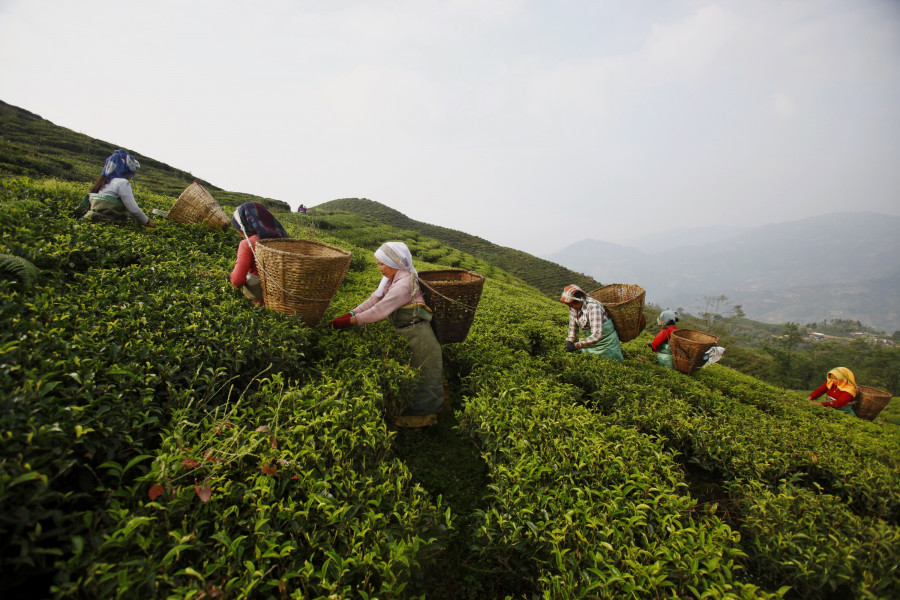Money
Higher tea prices push up Nepal’s export earnings
Tea exports see a steep jump of 150 percent to Rs2.18 billion. Shipments in the first quarter of the last fiscal year amounted to Rs871 million.
Krishana Prasain
Export earnings from listed products swelled 23 percent in the first quarter, largely as a result of tea prices climbing to record highs, traders said. The price of Nepali teas jumped by 40-60 percent on strong buyer demand and a huge shortfall in India.
Nepal exported goods listed in the Nepal Trade Integrated Strategy (NTIS) worth Rs9.22 billion during the three-month period from mid-July to mid-October, up from Rs7.49 billion in the same period last year.
Traders said part of the reason for the jump in export figures was the resumption of cargo movement after the end of the Covid-19 lockdown.
Amrit Lamsal, under-secretary at the Ministry of Industry, Commerce and Supplies, said that the production of agricultural products like tea and large cardamom declined in India and other South Asian countries, leading to greater demand for Nepali products.
Nepali products filled the gap created by production losses in India, Bangladesh and Sri Lanka, he said.
The ministry is planning to establish a single-window system to streamline trade and ease frontier formalities.
Lamsal said that the ministry would introduce a Trade and Investment programme with the support of the European Union, the Ministry of Agriculture and Livestock Development and the Trade and Export Promotion Centre.
The programme will help entrepreneurship development, and provide support for collective trade marks and technological enhancement.
Unless productivity is increased, exports cannot be expanded; and the ministry is working to increase productivity, he added.
NTIS products are reviewed every five years. The ministry will review the listed products this year and identify new potential products, Lamsal said.
“We will be including products that have high export potential and provide financial advantage. The ministry will name the products by studying the data provided by the centre,” he said.
“We are doing a feasibility study to establish a ginger processing plant so that the product can be exported directly from Nepal to third countries which will benefit farmers,” he said.
According to Lamsal, the major market for NTIS listed farm products is India. Europe and the United States are the largest buyers of NTIS listed handicraft goods.
Exports of tea, cardamom, ginger, pashmina, medicinal and aromatic plants and carpets increased during the first three months of the fiscal year while shipments of yarn, fabric and textile, footwear and leather dropped.
Tea exports saw a steep jump of 150 percent to Rs2.18 billion. Shipments in the first quarter of the last fiscal year amounted to Rs871 million.
Exports of Nepal’s tea have increased both in quantity and value, said tea traders. Demand for Nepali tea is at a peak due to shortages created in the Indian market after production was hit by heavy rain.
Deepak Khanal, director and spokesperson for the National Tea and Coffee Development Board, said that exports of remaining stocks, immense demand and increased consumption of tea in India boosted shipments of the Nepali product.
Tea accounted for 7 percent of total exports. Tea traders reaped a bonanza following a drop in output in the key growing countries, India and Sri Lanka, and increased demand in the global market.
Cardamom shipments rose by 16.6 percent to Rs1.47 billion from Rs1.26 billion in the same period last year.
The Large Cardamom Entrepreneurs Association of Nepal expects shipments to swell by 40-50 percent with good production this year compared to last year.
Nirmal Bhattarai, immediate past president of the association, said that export figures swelled as stocks that were in storage for four to five months due to the pandemic and lockdown were being dispatched, and production had also increased.
Cardamom is being exported at Rs800 per kg currently, but traders expect the price to reach Rs1,000 per kg soon due to a drop in production in India and Bhutan and rise in consumption.
According to Bhattarai, 90 percent of the domestic cardamom harvest is exported to India, and the rest to the Middle East.
Exports of pashmina soared by 35.9 percent to Rs771 million during the review period from Rs567 million. Pashmina traders said that products that had been in storage were being shipped in the past three months.
Textile shipments fell by 8.4 percent to Rs2 billion in the first quarter of the current fiscal year from Rs2.2 billion in the same period in the last fiscal year.
Carpet shipments saw an increment of 4.3 percent to Rs2 billion in the first three months compared to Rs1.95 billion in the same period in the last fiscal year. Ginger exports during the review period jumped sharply by 34.6 percent to Rs173 million from Rs127 million last year.
The export of footwear decreased to Rs185 million from Rs186 million.
Exports of medicinal herbs increased by 43.8 percent to Rs355 million from Rs247 million.
Leather exports declined by 68 percent to Rs21 million in the first three months of this fiscal year from Rs68 million in the same period in the last fiscal year.




 18.12°C Kathmandu
18.12°C Kathmandu















